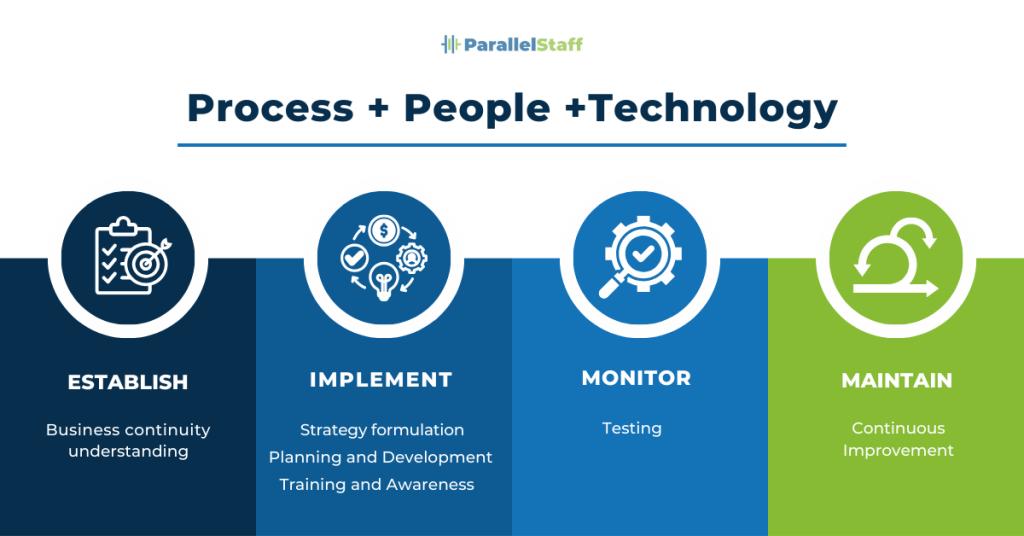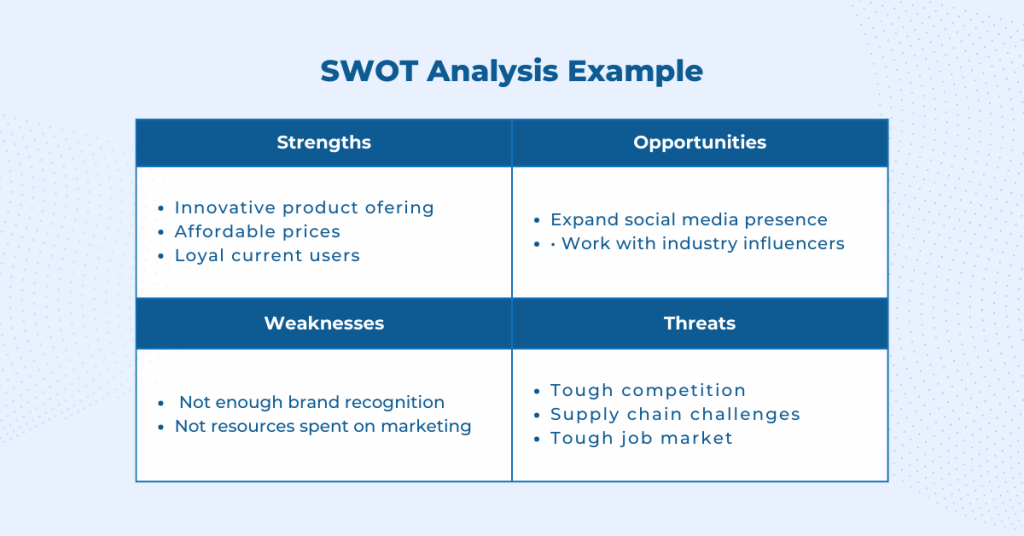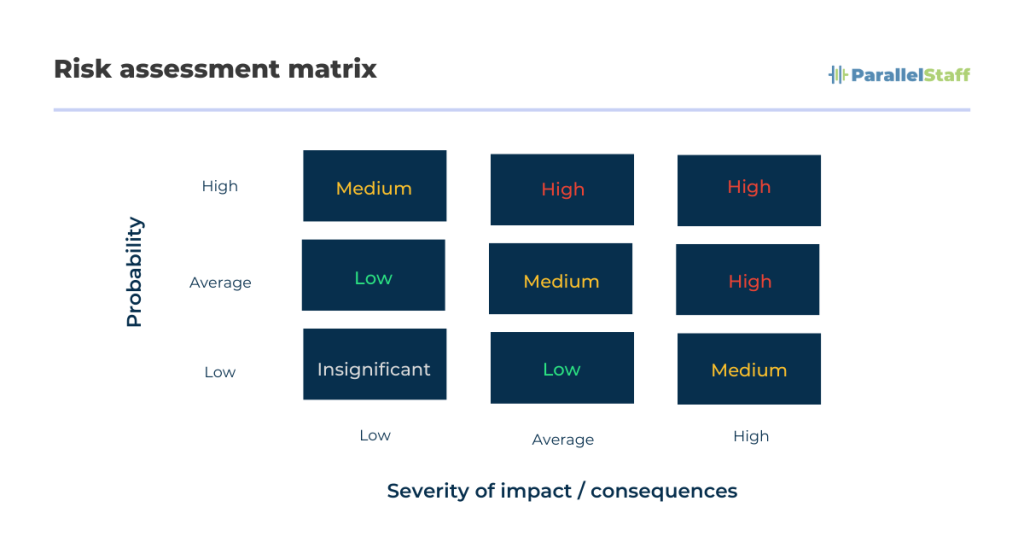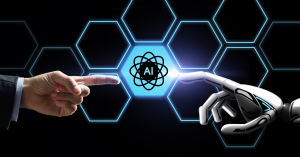In today’s rapidly changing world, it is crucial for businesses to be able to withstand unexpected events and adapt in order to achieve success.
This article explores the different components of business resilience and provides strategic advice on how companies can build strength to navigate through global disruptions.
What is Business Resilience?
In an era of rapid technological breakthroughs and worldwide interconnection, organizations’ resilience is continually tested by economic volatility, cyber-attacks, and unexpected disasters.

Business resilience is an organization’s ability to respond swiftly to interruptions while maintaining ongoing company operations and protecting people, assets, and brand equity. Such factors can include the cost of materials and supply chains, competition, and insufficient domestic demand, amongst many others.
Importance of Business Resilience in the Current Business Climate
Every day, the modern business landscape presents new problems that put organizations’ resilience to the test. Natural disasters and technical failures, as well as cyberattacks and global pandemics, are all possible sources of disruption. Businesses that can quickly adapt their operations and strategies to changes not only preserve their assets, but also position themselves as industry leaders.
A PwC Global Crisis and Resilience Survey from 2023 shows that 70% of respondents are confident in their ability to recover from a disruption but they lack foundational resilience requirements for success. However, 89% said resilience is one of their top priorities, indicating they see the desperate need for it following the global pandemic.
Following the Covid-19 restrictions, companies realise that establishing contingency plans is pivotal. As supply chains were heavily disrupted, many businesses were not able to survive. It is unlikely that such a major global event will happen in the near future, but the events taught us the lesson that we need to be prepared.
Understanding the Components of Business Resilience
Resilience is not a single trait, but rather comprised of several components that work together to form an effective business.

People: The Core of Resilience
The strength of any company is its employees. A resilient firm invests in its staff to ensure they are well-prepared, knowledgeable, and capable of efficiently responding to change.
Training programs that replicate emergency circumstances, resilience training, and regular communications are essential. Employees that are resilient can deal with stress better, adjust to new situations faster, and innovate under duress.
Processes: Creating Effective Systems
Resilient firms create procedures that absorb and react to shocks while minimizing performance degradation. These include flexible work options, strong IT systems, and clear standards for making decisions under pressure. The use of agile approaches can improve responsiveness by allowing for rapid changes to procedures, goods, or services.
Technologies: Importance of Tech Resilience
In the digital age, technological resilience is essential. This includes having secured, dependable IT systems that support corporate operations while adapting to changing cyber threats.
Investing in advanced cybersecurity measures, robust data backup systems, and disaster recovery plans ensures operational continuity while also protecting against data breaches and other technological interruptions.
Facilities: Physical Resilience in Infrastructure
A company’s physical assets, such as buildings, machines, and other important infrastructure, must be protected from physical threats. This includes adopting construction standards that can endure natural disasters, having backup power supplies, and executing proper maintenance plans to avoid system failures.
Each year, one in five startups fail due to poor infrastructure and support.
The Role of Leadership in Business Resilience
Leadership is pivotal in cultivating an organizational culture that values and practices resilience.
Vision and Strategic Direction
Leaders must establish a clear vision and strategy that prioritizes resilience. This includes assessing the potential hazards to the firm and proactively working to mitigate them. Leaders should promote resilience by incorporating it into their business strategies and policies.
Cultivating a Culture of Resilience
A resilient culture is based on the values of adaptation, collaboration, and constant progress. Leaders should promote open communication in which employees feel comfortable expressing issues and suggesting improvements without fear of repercussions. This culture aids in identifying and reducing problems before they become more serious ones.
Promoting Adaptive and Agile Practices
Encouraging flexibility and adaptability in operational methods enables businesses to respond quickly to changes. Leaders should foster an environment that encourages change, rewards creativity, and is always on the lookout for innovative solutions in preparation of upcoming issues.
Strategies for Building Business Resilience
To improve resilience, firms must create comprehensive strategies that address all aspects of their operations.
Risk Assessment and Management
Identifying possible risks and determining their impact on operations is critical. This includes both internal audits and external assessments to better understand vulnerabilities and the possible effect of various hazards.
- Identifying risks is the first stage in risk management. This includes both internal and external concerns. These can include financial, operational, technological, and geopolitical challenges. SWOT analysis (Strengths, Weaknesses, Opportunities, Threats) and PEST analysis (Political, Economic, Social, and Technological) are useful tools at this phase.

- After identifying risks, evaluate their possible impact on operations and likelihood of occurrence. This is often accomplished using a Risk Impact/Probability Chart, which helps prioritize hazards based on their severity and likelihood of occurrence.

- Based on the assessment, companies should put in place procedures to manage identified risks. This may involve diversifying supplier chains, investing in cybersecurity measures, or implementing flexible work arrangements to address varied eventualities.
- Risk management is a constant effort. Regularly scheduled assessments and constant monitoring of the risk landscape enable organizations to adapt their strategy in response to emerging risks and changes in the external environment.
- Internal audits, as well as audits conducted by external professionals, can provide an objective assessment of the risk landscape. These audits serve to validate the effectiveness of risk management measures and suggest areas for improvement.
Business Continuity Planning (BCP)
A strong Business Continuity Plan (BCP) is required to ensure that a company can continue operations in the event of a disaster.
- Business impact analysis entails identifying important operations and processes, as well as the necessary resources to support them. The business impact analysis assists in determining which aspects are most critical to the business’s survival and should thus be prioritized in the continuity plan.
- Each important function must establish techniques for managing and recovering from disruptions. This could include establishing alternate supply chain routes, developing redundant data storage systems, or planning for backup power supplies.
- The continuity plan should include specific step-by-step response strategies for various scenarios, as well as contact information for important staff and emergency agencies. Clear duties and responsibilities should be provided to ensure that everyone understands their jobs during a disruption.
- Regular testing of the BCP is critical to ensuring its efficacy. This testing can take the shape of tabletop exercises, simulations, or actual drills. Each test should be followed by a review session to fine-tune the plan based on input and findings.
- The BCP should be a dynamic document that is routinely updated to reflect new business processes, technology advancements, and emerging threats. This keeps the plan relevant and effective.
Effective Communication Strategies
Communication is a critical element of managing both everyday business operations and emergency situations effectively.
- Establish explicit protocols for who should convey what and how, during various types of crises. This includes assigning spokespersons and establishing a communication structure that extends from top management to the operational level.
- Use several communication methods and channels to guarantee redundancy. Email, SMS, intranet, social media, and emergency notification systems can all help ensure that communications are delivered swiftly and efficiently to all stakeholders.
- Create customized communication plans for different crisis scenarios, including essential messages, target audiences, and timelines. This preparation aids in maintaining clarity and control over the information transmission process during high-pressure situations.
- Employees benefit from regular training sessions and communication drills, which help them prepare for any situations. These trainings should address the team’s internal communication procedures as well as exterior communication with customers, suppliers, and the public.
- Implementing feedback tools to assess communication effectiveness and make real-time adjustments is critical, particularly during a crisis.
Case Studies in Business Resilience
To illustrate the power of effective resilience strategies, consider the following real-world examples, one showing the failures of business resilience and another showing the benefits of a resolute strategy.
Nokia
Nokia’s decline provides a cautionary example of the consequences of lacking operational resilience. Once the world’s leading mobile phone manufacturer, Nokia excelled in producing affordable, functional phones and enjoyed significant market share and revenue.

However, the company’s heavy reliance on hardware and reluctance to embrace smartphone software innovations became apparent when iOS and Android entered the market in 2007. Over the next three years, despite witnessing a steady drop in sales, Nokia failed to adapt to these market changes.
This inflexibility in response to external pressures and an inability to innovate led to a rapid decline in Nokia’s capabilities and market share. By 2013, only six years after dominating the global mobile market, Nokia was forced to sell to Microsoft. This downfall illustrates the importance of operational resilience—the capacity to anticipate, plan, and manage external changes effectively. Had Nokia established a robust operational resilience framework, it might have been better equipped to address these disruptions promptly and mitigate their adverse effects, potentially averting the company’s rapid decline.
Shopify
In contrast to Nokia, Shopify stands out as a model of operational resilience, particularly evident during the COVID-19 pandemic. The pandemic highlighted the necessity for companies to adapt to remote and hybrid work environments. Shopify, having previously embraced the concept of remote work due to earlier challenges, was well-prepared for this shift.
In May 2020, Shopify declared it would adopt a “digital by default” stance, transitioning to a remote-first hybrid work model that enabled most of its employees to work from home effectively. This shift was seamless due to Shopify’s prior experience with time zone challenges when expanding to service international merchants. The company had already implemented flexible working arrangements in response to the negative impacts of graveyard shifts on employee well-being, which reduced attrition rates among its workforce.
This foresight in managing smaller disruptions equipped Shopify to handle the larger scale disruption of the pandemic efficiently. With a risk management framework that had already adapted to flexible work arrangements, Shopify could transition smoothly into a predominantly remote work setup, a change that is likely to persist.
Overcoming Challenges in Building Business Resilience
Building resilience is not without its challenges, particularly for businesses grappling with limited resources or those in highly volatile markets.
Anticipating and Navigating Change
Businesses must develop the ability to foresee potential issues and prepare strategies for adoption. This requires ongoing environmental scanning and a willingness to invest in new technology and processes that can assist eliminate identified hazards.
Ensuring Sustained Employee Engagement
Employee engagement is crucial for resilience. Employees that are disengaged are less likely to contribute to resilience-building activities and more likely to leave the firm during a crisis. Companies must build a culture of participation by recognizing, empowering, and providing chances for continual learning.
Dealing with Limited Resources
Many small and medium-sized businesses have substantial resource constraints when adopting resilience measures. Prioritizing crucial areas such as cybersecurity, employee training, and necessary infrastructure can help these organizations develop a resilient foundation that can be expanded when resources allow.
Business Resilience in the Digital Age
The digital transformation has introduced both challenges and opportunities in building business resilience.
Digital Transformation and Business Resilience
Leveraging digital technologies can help businesses become more agile and resilient. For example, cloud computing gives businesses with flexible data storage options and scalability, while AI and machine learning can aid with predictive analytics, boosting decision-making in crisis situations.
Cybersecurity and Data Protection
As firms become more digital, the risks posed by cyber threats grow. Implementing robust cybersecurity safeguards is critical for securing sensitive information and ensuring operational integrity. A robust digital strategy includes regular audits, personnel training on cybersecurity best practices, and the implementation of advanced security solutions.
Future Trends in Business Resilience
There are two primary trends that are likely to impact the future of business resilience,
Impact of AI and Automation on Business Resilience
AI and automation will continue to revolutionize company processes, increasing operational efficiency and resilience to human mistake and personnel volatility. These technologies can help improve risk management by detecting and addressing possible disruptions in real time.
The remarkable early successes of Generative AI (Gen AI) have captivated the public and industry leaders alike, drawing attention to its potential for boosting revenue and enhancing the value of existing products, in addition to its ability to reduce costs. Gen AI finds its utility in various business functions, ranging from creating targeted marketing content and assisting customer service operations to improving software development processes. Embracing these opportunities will necessitate substantial investments in recruiting AI talent, acquiring new technologies, and reskilling employees.
Despite these prospects, it’s crucial for business leaders to be aware of the risks associated with Gen AI, including potential threats to intellectual property, errors in AI-generated responses, and inherent biases. Companies are advised to approach Gen AI projects cautiously, using their top talent and establishing robust frameworks and guidelines.
Moreover, executives should continue to invest in traditional digital transformations such as enhancing Order-to-Cash processes, optimizing cloud data migration, and integrating data analytics across business functions. These efforts will bolster the benefits realized from Gen AI innovations, ensuring sustainable growth and competitive advantage.
Incorporating Sustainability into Business Resilience
Sustainability is becoming more closely linked to resilience as organizations appreciate the long-term benefits of environmentally friendly activities and their role in managing risks connected with environmental and regulatory changes.
Customers and investors are increasingly assertive in their demands, compelling businesses to prioritize sustainability for long-term success. This involves adopting business models that emphasize efficient resource utilization, minimize environmental impact, and generate social value.
Conclusion: The Road Ahead for Business Resilience
Building business resilience is a continuous process that involves dedication, investment, and strategic planning. Understanding the main components of resilience, harnessing technology, and developing a supportive culture can help organizations negotiate the difficulties of the modern world and emerge stronger from barriers.
Key Takeaways
- Resilience is multifaceted, encompassing people, processes, technology, and infrastructure.
- Proactive and strategic leadership is crucial in fostering an organizational culture that values resilience.
- Digital tools and technologies play pivotal roles in enhancing business agility and security.
- Sustainable practices are essential for long-term resilience and business success.
By implementing these strategies, businesses can ensure they are not only prepared for today’s challenges but are also well-positioned to seize future opportunities.
ParallelStaff supports your business resilience strategy.
In the ever-evolving landscape of business resilience, having the right tech talent is crucial to adapt and thrive amidst challenges. ParallelStaff stands ready to bolster your in-house capabilities by connecting you with dedicated, highly-qualified tech professionals from Latin America, all within your time zone.
With a focus on providing cost-effective solutions without compromising on quality, ParallelStaff can help you effortlessly build and scale your development team. Their approach promotes long-term collaboration and alignment, ensuring that your tech solutions are not only robust but also seamlessly integrated with your business needs.
If you’re looking to strengthen your business resilience through superior tech talent, contact ParallelStaff today to learn more about how their nearshore dedicated teams can drive your projects forward.
- How Can You Identify the Best MEAN Stack Developers to Hire? - May 27, 2024
- Unlocking Global Talent – The Power of Offshore Software Development - May 14, 2024
- Thriving Through Turbulence: Building Business Resilience Strategies - April 16, 2024






